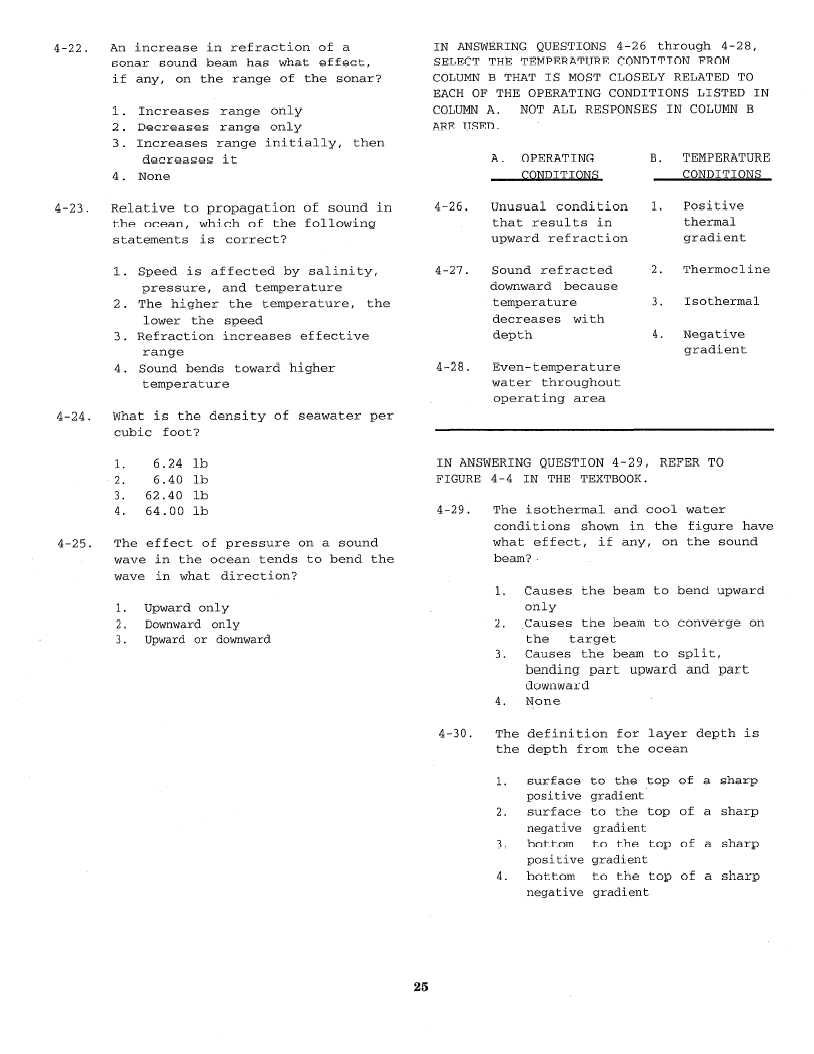4-22.
An
increase
in
refraction
of
a
sonar
sound
beam
has
what
effect,
if
any,
on
the
range
of
the
sonar?
1.
Increases
range
only
2.
Decreases
range
only
3.
Increases
range
initially,
then
decreases
it
4.
None
4-23.
Relative
to
propagation
of
sound
in
the
ocean,
which
of
the
following
statements
is
correct?
1.
Speed
is
affected
by
salinity,
pressure,
and
temperature
2.
The
higher
the
temperature,
the
lower
the
speed
3.
Refraction
increases
effective
range
4.
Sound
bends
toward
higher
temperature
4-24.
What
is
the
density
of
seawater
per
cubic
foot?
1.
6.24
lb
2.
6.40
lb
3.
62.40
lb
4.
64.00
lb
4-25.
The
effect
of
pressure
on
a sound
wave
in
the
ocean
tends
to
bend
the
wave
in
what
direction?
1.
Upward
only
2.
Downward
only
3.
Upward or
downward
IN
ANSWERING QUESTIONS
4-26
through
4-28,
SELECT THE TEMPERATURE CONDITION
FROM
COLUMN B THAT
IS
MOST CLOSELY
RELATED
TO
EACH OF THE OPERATING
CONDITIONS
LISTED
IN
COLUMN A.
NOT ALL
RESPONSES IN
COLUMN B
ARE USED.
A.
OPERATING
CONDITIONS
4-26.
Unusual
condition
that
results
in
upward
refraction
4-21.
Sound
refracted
downward
because
temperature
decreases
with
depth
4-28.
Even-temperature
water
throughout
operating
area
B.
TEMPERATURE
CONDITIONS
1.
Positive
thermal
gradient
2.
Thermocline
3.
Isothermal
4.
Negative
gradient
IN
ANSWERING QUESTION
4-29,
REFER TO
FIGURE
4-29.
4-30.
4-4
IN
THE TEXTBOOK.
The
isothermal
and
cool
water
conditions
shown
in
the
figure
have
what
effect,
if
any,
on
the
sound
beam?.
1.
Causes
the
beam
to
bend
upward
only
2.
Causes
the
beam
to
converge
on
the
target
3.
Causes
the
beam
to
split,
bending
part
upward
and
part
downward
4.
None
The
definition
for
layer
depth
is
the
depth
from
the
ocean
1.
surface
to
the
top
of
a sharp
positive
gradient‘
2.
surface
to
the
top
of
a sharp
negative
gradient
3.
bottom
to
the
top
of
a sharp
positive
gradient
4.
bottom
to
the
top
of
a sharp
negative
gradient
26


